Lighting has a big impact on the rooms in your house or the work spaces in your office. A beautiful room can look bad because of bad lighting and an ugly space can get a much better look thanks to quality lighting.
In recent years, there has been a broad interest in light, lighting and lighting design among designers throughout the world, but also among architects. One of the main reasons behind this, is the growing awareness of the fact that architecture in 2017 has become more thoughtful and increasingly uses free forms. This also increases the need for quality architectural lighting. Standardized light concepts might still meet the more static architecture of the recent past, but the variation we see in contemporary architecture requires diverse and distinctive possibilities in terms of lighting.

That's why the range of light sources and luminaires we know today is so extensive. So that it is seamless and perfectly implementable in a lot of different architectural designs. An architect has no need for lighting devices, but for light, atmosphere and comfort. The product should be minimally present in the architecture and should be kept in the background, so the light can steal the show. Not the luminaire. Successfully integrating lighting in your design requires knowledge and insights about products, technologies and especially about the effects and impact of light.
Good lighting brings about positive effects that may be of importance to quality of life and which can affect comfort, productivity, and even human health. On average, about 20% of the energy consumption in a building goes to lighting. Do not underestimate its value, so take the time to have an eye for energy efficiency in a lighting plan.
Good light quality is based on the balance between three pillars:
-
Human needs
-
Architectural considerations
-
Energy efficiency
Human needs
It has been proven more than once that the quality of light in a building affects the people in it. Thus, the satisfaction and productivity of an office employee can be positively influenced by a well-designed lighting plan. Owners or managers have the potential to add value and reduce costs by investing in good, qualitative lighting. It is no secret that people are attracted to well-lit public facilities, commercial complexes or parks. Good lighting improves the mood and desirability of such spaces and can greatly contribute to a sense of well-being.
Architectural considerations
Evolutions in techniques and technology have made the role of a lighting specialist or lighting designer crucial for the success of an architectural project. The possibilities have become endless. However, seamless integration into modern architecture becomes more complex with the day and requires knowledge. Lighting design has become a creative extension of architecture. The main objective of lighting in an architectural design can be deduced to compliment the present shapes and colors.
Energy efficiency
We are aware that energy costs and efficiency today are more important than ever. In each project, one should aim for a result with a small ecological footprint and strong performance in terms of sustainability and energy consumption. Light control is a way to make your lighting ‘perform’ better on these elements. By using dimmers and (intelligent) controls, for instance, you can enlighten a space to the task that is performed in that location. Integration with other ventilation or airco technologies can also play a role in this.

Because Kreon always starts from the architectural design, we can enter into a dialogue with the architecture as an equal partner. Kreon, purity in light, allows you to create the perfect conditions under which the beauty of your design can come to the surface in the most optimal way.


